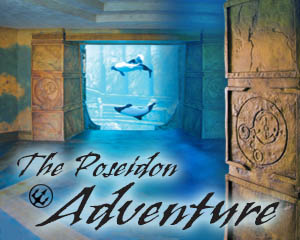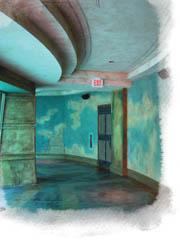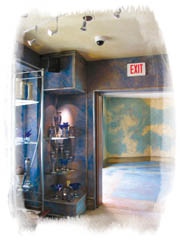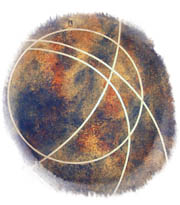

FauxUnique was contracted to duplicate, translate and create the interior spaces that are a part of the theme of the mythical city. Walls with milky way galaxies, half-moons and suns were all part of the overall design, which was specified entirely in a plaster finish. The company worked closely with Wilson, transcribing the ideas formed from the CAD and color drawings to the walls.
"Translating the concepts and drawings that they (the designers) had on paper and in their minds' eye to reality on a wall surface was an interesting challenge, especially considering that the overall theme of the design was the mythical lost city of Atlantis," says Riddle. "Being able to transform plain drywalls into the magical surroundings of an ancient sunken city was an adventure we were excited to be a part of."

Knowin' Minoan
Throughout the process of creating the underwater city, FauxUnique and the designers relied on overnighting color samples, e-mailing electronic files, and even taking pictures with a cell phone, to send instant updates on the job's progress. Through these mediums, communication between the companies helped to confirm or adjust FauxUnique's output on the spot, usually with very minor modifications being made to the work in progress. And all of this achievement was done without the need for the designer to be there around the clock. With the utilization of these technologies, the contractor and designer were able to save a large amount of time and money by communicating to each other thoughts and ideas about the project, instead of waiting for flights from St. Louis to the job site and back."It was an interesting dichotomy in motion," says Riddle. "Here, we were using all this 21st century technology to accomplish the look and feel of an ancient city; a city basically devoid of any technology."
FauxUnique first began the process of installing the Texton Marmarino plaster finish by applying a high-quality water-based primer over the Level-4 finished wallboard in the Gift Shop, Photo Booth and Dolphin Viewing Rooms.
"Because Texston's products are of high certified restoration quality, all they generally require over most substrates is a good water-based primer," Riddle adds.
Once the colors were approved for all the rooms, the company began to apply the base color. The Dolphin Viewing Room was to be three basic colors in addition to a slight tea stain and gold metal accent. It was the area that would carry the most dramatic effects of being underwater for so long, complete with deteriorated plaster walls and stained water sediment lines. The Photo Booth area (a room where visitors can purchase pictures of themselves on the Journey to Atlantis ride) was "less dramatic and more subtle." That finish was to be more of an aged limestone look. The third room, the Gift Shop, was to be the one that reflected more of the culture and society of Atlantis, complete with stars, galaxies and things of a celestial nature.
To achieve the interesting, out-in-space looking finish, the company knew they would have to devise a new and different method of application to achieve the look of stars and galaxies.
"We wound up using standard 2-gallon texture spray hoppers," Riddle says. "We wanted a way to apply the finish that gave us complete control over color, depth and texture. Because we weren't going to be doing 50,000 square feet of space, there was no need to load up a great big standard stationary hopper and blow it through a 100-foot hose. I used a medium sized gas-driven compressor and a hopper you can get at Home Depot. To my knowledge, I believe we're the only company to ever apply an authentic lime and stone based finish in this manner."
The company needed to use the hopper to apply the Marmarino plaster because it would give a pixilated look and by varying the size and color of the pixels, the workers could achieve the appearance of different galaxies in space. With this tool, they were able to control the final finish by playing with the apertures on the sprayer to get the various granule or pixel sizes required. Riddle says that if they had used hand trowels, they would have never achieved that look.

By Zeus!
After all the colors were applied to create the final solar system-like appearance, the company then applied a tea stain aging dye over all the walls to help add to the illusion of an ancient city. As the finish was completed and then clear-sealed, the company had to engrave large, sweeping arcs and circles made out of 11⁄2-inch lines that were hand scribed and inlaid with pewter into the walls. The process was very meticulous, interpreting from computer-illustrated images as to what the lines should look like. The company had to brush up on its algebra, applying math to get the application right."We actually used some old-school methodology in putting those arcs in place by basically determining the wall height and length, where we needed to have the arcs set as per the computer drawings and then use a nail and string to lay it out," says Riddle. "We would put a nail in the center of where a circle needed to be, measured out the radius with the string, spun the string around with a pencil at the end and presto, we had our circle.
"We had to do quite a bit of mathematical calculations-actually my brother Scot was very good at that-to properly place the arcs that span all the walls in the Gift Shop. We had to go through and scribe all those arc lines using basically the nail and string technique. It was quite a challenge but in the end it was satisfying to see it all come together.
"After we scribed all the lines, we then taped them off with 3M's 60 Day Blue Tape, because it's thinner and more pliable, and it gives a much cleaner edge," he continues. "Because we wanted the most dramatic and realistic inlaid effect with the most relief possible, we had all the lines scribed and taped first and then we applied the entire plaster finish right over all those taped lines. When we were completely done with the finish, including sealer, tea stain, everything, we pulled the tape off and hand painted every one of those scribed lines with little artist brushes and a cold-caste pewter metal coating. That's real ground pewter in all those linesænot paint. It's a very interesting product. It's a water-borne, polymer resin, UV-stable coating with finely ground pewter added. The color you see in the lines is from the pewter and not colorants. When we were finished it looked like there was real metal banding inset into the walls."
After applying the pewter coating, the company had to carefully apply an aging dye over the pewter to give the bands an old patina look. All of it was hand applied, with the company being extremely careful not to get any of it on the freshly completed wall finish. Any mistake, of course, would have spoiled the finish and reset most of the job.
The Dolphin Viewing Room was much more conventional in its application techniques, yet hardly average considering the look called for by the designer. It isn't always common for contractors to get creative direction to make plaster walls look as if they have been underwater for hundreds of years, complete with missing plaster, aging effects, sediment lines and the occasional exposed gold shale.
They started by first hand trowelling the base Marmarino plaster coat in two combined colors of purple and faded blue. After that came the yellowish-hued plaster coat applied to look like the crumbling, leeched-out part of the plaster. Almost all of the colors in the Dolphin room were wet-blended together to create a more homogenous, fused appearance. This room also received the aging dye but careful attention was paid to the lower portion of the walls. FauxUnique strategically placed varying amounts of a second application of the aging dye to replicate the look of extra sediment build-up on the walls from the effects of gravity, water currents, etc.
The company was given the task of replicating gold vining in the brick/block work that the people of Atlantis were imagined to have had in its wall systems. In the Gift Shop, this gold veneer was sprayed with a texture to have a solar system type of look, with "a little hint of New Age." In the other rooms, the company applied this gold vining "as in the breaking off of certain substrate areas, like the subterranean earth, and seeing the exposed veins or shale looking like gold, almost mica."

For Cleito
The company prides itself in always experimenting with new and different tools to achieve unique finishes. When asked about what tools were used for this job, Riddle says everything from "high-end German stainless steel knives but found that those $0.88 yellow plastic knives worked great for other applications on this job."One thing the company likes to avoid using if at all possible is solvent-based materials. It prefers products that are water-based for many reasons. One of those reasons is that with all of California's EPA regulations, Riddle figures it's just a matter of time before solvents are sunken in Davy Jones' locker. So why build a dependency on products that may not be around for very long?
"We've never really liked (solvents) anyhow, because of the fumes, which our clients don't enjoy and it usually takes longer for oil-based products to dry," he says. "We're always looking for the latest and greatest water-borne product to use. We use glazes now that have open (or working) time that is as long as oil, clean up is easy and there are hardly any fumes. In fact, this Sea World project is entirely water-based; including the sealer."
The Journey to Atlantis project is the latest in the company's high-profile gigs, joining the A-list of clients that include the former ambassador to Singapore, the family of founder Irwin Jacobs of Qualcomm, and numerous other dignitaries, including many elite corporate and commercial accounts. FauxUnique's primary members Mike Riddle, wife Debra, and brother Scot Riddle plan to keep on producing unique, inventive, and authentic finishes as they continue to grow the company.
And what does TexSton make of the anarchy that FauxUnique is practicing with its product?
"We love it," says its President Nurit Regev. "The color choices of the sample that was created (for the Gift Shop) were unusual. It's a very modern look-almost futuristic. The final installation ties the color palette and textures together beautifully. The deep blue hues and contrasting radiance of the orange, both done in our Marmarino plaster (a modern version of ancient polished stucco) make the room full of life."
Unless plate tectonics should strike the west coast and sink the state of California or until Professor Jacques Collina-Girard's archaeological dig stumble on the ruins of the great mythical architectural beast, the Journey to Atlantis at Sea World San Diego is the closest one may get to experience the look, feel and texture of the city.
"We tried to convey as completely as possible what the designer imagined the sunken city of Atlantis would look like after being underwater the many hundreds of years folklore says it has" Riddle comments. "Our job was to carry the theme of this lost city throughout the project, and to make it look and feel as though you were really there, an honorary citizen walking about the city, experiencing the surroundings of a place that was doomed to the sea, yet curiously preserved by that very sea."

